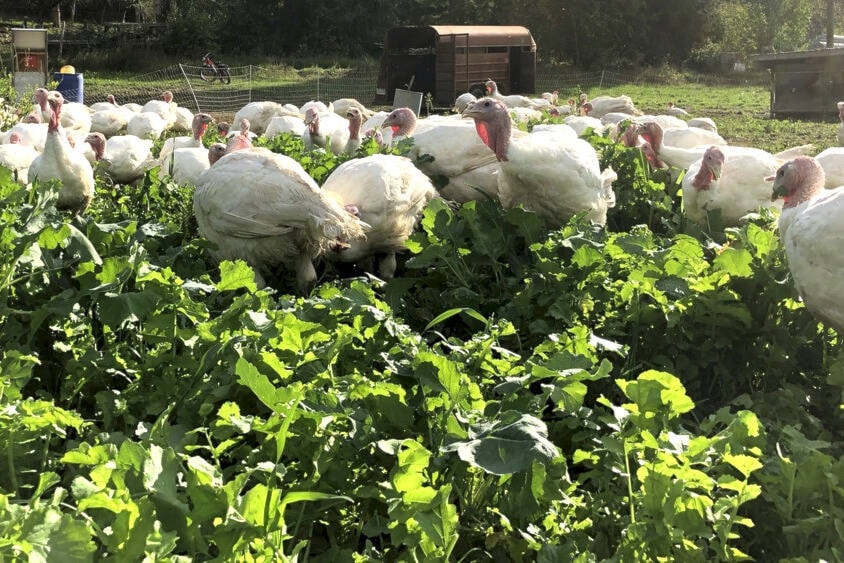By Eli Pivnick
Climate Change
Regenerative agriculture is an old idea that has been re-ignited because of its promotion as another valuable action in reducing greenhouse gases to help end the climate crisis. The 2020 Netflix documentary Kiss the Ground and the 2018 book From Dirt to Soil by Gabe Brown, have helped to popularize this approach to agriculture.
In the last 100 years, it is estimated that agricultural lands in the U.S. have lost one third of their soil, and much of their fertility, sharply reducing the soil’s ability to produce food. And the loss continues in Canada as well. Not only is this a problem for food security but it is well established that healthy soil stores an enormous amount of carbon.
Andrea and Steve Gunner practice this technique on a small farm near Armstrong where they raise 2,000 chickens and 300 turkeys per year. The Gunners have a series of fenced paddocks and rotate the poultry frequently from one to the next. This gives their pastures a lot of fertilizer and a significant recovery time. For the poultry, it supplements their diet of organic grains with many kinds of fresh plants and insects. The young chicks are scared of insects until a few brave ones sample them. From then on, whenever chickens discover insects, they get all excited for the tasty treats!
The use of animals and the frequent rotation of pastures are among the key elements of regenerative agriculture. Andrea, an agricultural economist, explains that having animals on the land, reactivates the soil by introducing many species of microbe. According to her, there are roughly 17,000 beneficial species of bacteria for every one that is harmful.
Barry Both, near Salmon Arm, raises 160 dairy goats. He has been transforming his operation to regenerative practices since 2019. According to him, it has required a change in attitude. He wanted to improve his land, the water, biodiversity, and at the same time reduce the stress on his goats and himself. He has reduced his milking to once a day and the goats now spend the majority of the year on pasture. In doing soil tests, he discovered that there was twice as much organic matter where the land had never been cultivated. He hopes to return the rest to the same state.
Steve Meggait and Annelise Grube-Cavers run an organic farm on 300 acres near Armstrong. They raise cattle as well as turkeys and chickens all on pasture with frequent rotation. They sell boxes of meat every month to subscribers, and there is always a waiting list. Steve says that they minimize soil cultivation and keep the animals on pasture until snow makes it impossible. Two thirds of animal fertilizer is lost if the animals are not on the soil.
Cattle, sheep and goats are ruminants, animals which ferment their food in multiple stomachs. They are responsible for the production of large quantities of methane, which is a greenhouse gas 80 times more powerful than CO2. While some of it is produced in ruminant stomachs, a large part of the methane comes from the production of grains especially corn, used in their diet. But in regenerative agriculture, cattle and other ruminants only eat grass. As well, this method allows the soil to store lots of carbon. This is why regenerative agriculture and the resulting meat products are considered to be climate solutions, not climate problems.
There is excitement about regenerative agriculture according to Both, who was amazed at the enthusiasm shown by area farmers when he called a meeting to discuss it just before the COVID crisis hit. The B.C. government has just created the Regenerative Agriculture and Agritechnology Network to promote it. Unfortunately, so far the Network seems to be promoting potential technologies involved when it is really a very low tech system of farming which is at the heart of regenerative agriculture. You can expect to be hearing more about the promise of this approach to farming.
Eli Pivnick is a former Agriculture Canada research entomologist, high school teacher, and currently a wilderness guide and freelance journalist. elipivnick@ymail.com
READ MORE: Avian flu confirmed at Enderby farm
READ MORE: Northern Lights dance over Vernon
@VernonNews
newsroom@vernonmorningstar.com
Like us on Facebook and follow us on Twitter.
